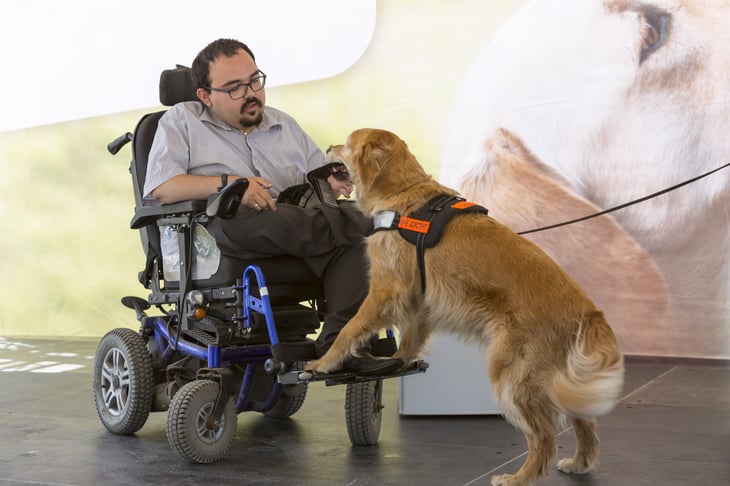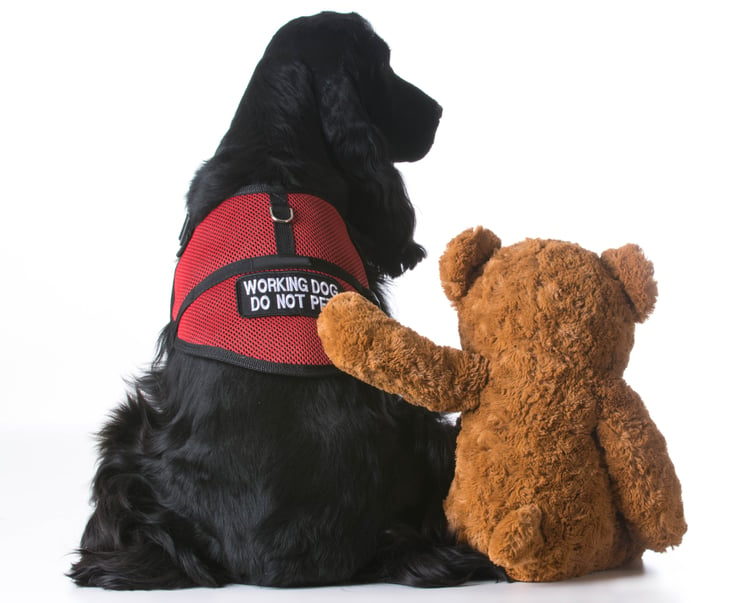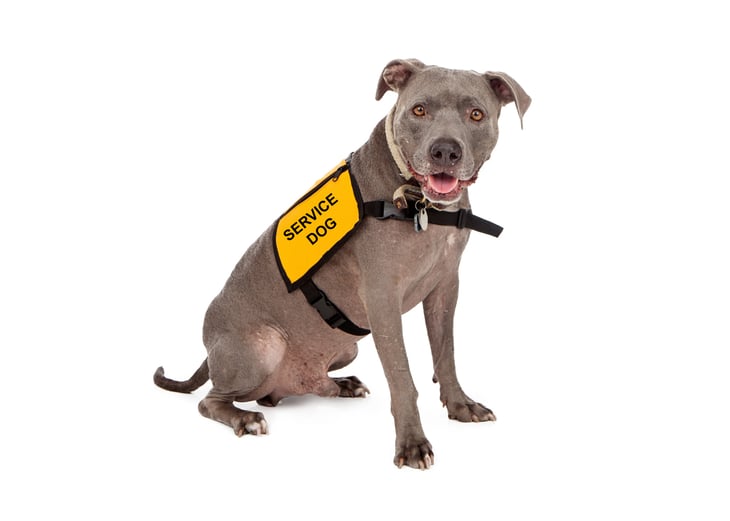
Do you hate going anywhere without your beloved pet? It is cheap, quick and easy to get online certification of your dog (or kitty or hamster) as an “emotional support animal,” allowing you to take your furry or scaly friend into restaurants or stores, on planes and into other places usually reserved for Homo sapiens.
ESAs are becoming more common, as you may have noticed when you are out and about. If you are tempted to join in there are a few things you should consider.
First, understand that ESAs are not the same as service animals (sometimes called guide dogs), which are allowed to go nearly everywhere. Federal law doesn’t spell out the requirements or access for ESAs as it does for service animals such as guide dogs for the blind.
Also, know that some pet owners are stretching the reasonable use of ESAs, sparking controversy and conflict. Read on and then decide whether declaring your animal an ESA is the right choice.
Assistance animals, by type

Four common designations for assistance animals are:
- Service animals: The Americans with Disabilities Act defines a service animal as a dog or, sometimes, a miniature horse that is “individually trained to do work or perform tasks for a person with a disability.” These are working animals, not pets, and their jobs must be directly related to the person’s disability. Service animals receive lengthy, expensive and specialized training that enables them to perform tasks for disabled owners. There are dozens of things they may do: open doors, switch lights on and off, retrieve medicine and other objects, alert a hearing-impaired person to sounds, provide balance assistance, or alert to possibly deadly diabetic conditions, for a few examples.
- Psychiatric service dogs: These are service dogs trained to assist people with diagnosed disabilities, including anxiety disorders, severe depression and post-traumatic stress disorder (PTSD). “The ADA does not grant ESA owners the same right of access to public places that it gives to individuals who use psychiatric service dogs,” according to Nolo. “That means that under the ADA, a movie theater, for example, must allow psychiatric service dogs to accompany their owners into the movie auditorium but can refuse to admit individuals with emotional support dogs.”
- Emotional support animals: These are pets with no specialized training to “perform tasks for the benefit of an individual with a disability,” as the ADA requires. Rather, “the pet’s owner simply derives a sense of well-being, safety or calm from the dog’s companionship and physical presence,” says Nolo. ESAs don’t qualify as service animals under the ADA, says this detailed booklet on the laws and the differences, which can be found at the ADA National Network website. It’s easy to find sites offering to credential your pet as an ESA — some with few or no requirements or questions asked. Says one online ad: “Take your dog anywhere. How to make your dog a service dog.”
- Therapy dog: In this final category — not to be confused with any of the above — are dogs are used to perform a service in public by comforting and greeting others rather than helping their owners. So, they do things like go with their owners to volunteer in settings like schools, hospitals and senior care facilities, to improve the lives of people there.
Controversy

Growing numbers of people are bringing pets along wherever they go, in theaters, restaurants, on planes and in other public places. Some flash credentials purchased online, others have letters from their therapists, and some simply dress up the animals in official-looking vests and gear they’ve purchased.
But let’s face it: For some people, designating a pet an ESA is more opportunistic than it is therapeutic.
“You get on an aircraft, and the cabin looks like a barnyard,” said Hollis Gillespie, a former flight attendant, speaking to Today.com. Gillespie, who said she’s seen snakes, birds and pigs traveling with passengers, suggests that saving money is one reason that people declare their pets ESAs: Passengers who bring their animals on board with this designation can save hundreds of dollars that would be required to transport their pets otherwise.
Writes the Los Angeles Times:
Several companies sell ESA evaluations, letters, registration cards and other accessories on the Web, sometimes requiring telephone interviews, sometimes operating on the honor system. But there is no federally recognized registry for any kind of companion animals (service, therapy or emotional support), so consumers should expect no guarantees from these vendors.
New Yorker writer Patricia Marx experimented to see how far she could get (as far as she wanted to, it turned out) with “emotional support” credentials purchased from a website and five different animals (one at a time): a pig, turkey, snake, alpaca and a turtle.
She boarded an airline flight with Daphne, a pig. She writes: “Passing through security with a pig in your arms is easier than doing so without one: You get to keep your shoes on and skip the full-body scanner.”
Also, given the low bar for certifying ESAs, it’s not surprising that some act just like other pets:
Marx reports how a “service dog” that took a squat– two squats, actually — on a US Airways flight from Los Angeles to Philadelphia several years ago — prompting the pilot to make an unscheduled landing in Kansas City to unload the owner and dog. Passengers were getting sick, tweeted a man who’d been on the plane. Marx concluded: “One person’s emotional support can be another person’s emotional trauma.”
Backlash

Given all the categories and the lack of licensing or consistent rules, it’s understandably difficult for restaurant owners, shopkeepers and others to tell the difference between legitimate service animals and pet owners with online credentials.
Those who challenge a dog’s credentials must be careful to respect the law. The ADA Network booklet says:
When a person with a service animal enters a public facility or place of public accommodation, the person cannot be asked about the nature or extent of his disability. Only two questions may be asked:
1. Is the animal required because of a disability?
2. What work or task has the animal been trained to perform?
But many business owners are reluctant to challenge the use of animals for fear of violating the ADA.
So, in some places, the growing number of “support animals” is sparking a backlash.
In Texas, legislators are considering a bill banning “fake” service animals. Texas Tech student John Vickers, who is visually impaired, told Lubbock’s Channel 6 that the proliferation of animals in public places creates problems:
“It’s just very discouraging when you get to some place and people have been there with their fake service animals, or proclaimed service animals, and they’ve set a bad image for people like myself with a real service animal,” Vickers says.
“I’ve seen some sad situations, where false certifications and harnesses and vests that go on these service animals are sold online for around $100. It actually costs about $42,000 to train a service animal,” Vickers says.
So, what to do if you feel you legitimately need an ESA?
Psychology Today writer Hal Herzog, emeritus professor of psychology at Western Carolina University, at Psychology Today, recommends obtaining a letter from a mental health professional attesting that you need the animal to help manage a recognized psychiatric disorder and carry the letter when you’re in public with your ESA.
The rules

Besides the ADA, other federal, state and local laws may cover the use of animals in public places. These include:
- The Fair Housing Act, which covers “virtually all types of housing, including privately owned housing and federally assisted housing, with a few limited exceptions,” defines and allows “assistance animals.”
- The Air Carrier Access Act, which defines and governs how “service animals” are allowed on planes and other forms of transportation, forbids discrimination against people who are using service animals. According to an ABC story:
Federal regulations allow a legitimate emotional support animal, whether it be a dog, a cat, a pot-bellied pig or even a miniature horse in one case, to travel on airplanes in the cabin with the owner, outside of a carrier, and for free if the owner has proper documentation, which means a letter from a doctor or other mental health professional. The animal must be well-behaved, and there must be adequate space onboard. The airlines are allowed to ask people traveling with emotional support animals for that documentation, but they are not required to.
- Airline rules: Each airline sets its own policies about allowing animals in the passenger cabin. Since airlines often allow ESAs — with a letter from a therapist and adequate advance notice — to fly with an owner free of charge, the practice is growing in popularity. Use BringFido to see individual airlines’ rules.
- State rules: You’ll find each state’s definitions, requirements for accommodating assistance animal on the Table of State Assistance Animal Laws (good through 2016) provided by the Michigan State University College of Law’s Animal Legal and Historical Center.
The LA Times describes the patchwork of rules for ESAs:
The federal Air Carrier Access Act, on the other hand, allows ESAs to fly in the passenger cabin on commercial flights at no extra charge, usually on the passenger’s lap or in a carrier under the seat. The federal Fair Housing Act permits ESAs in condos or apartments that ban pets. That law doesn’t cover hotels, but many upscale lodgings accept ESAs, including some that ban conventional pets.
Some state legislatures are trying to address a growing number of abuses. According to the Associated Press:
Under the Americans with Disabilities Act, it’s a federal crime to use a fake [service] dog. And about a fourth of all states have laws against service animal misrepresentation. But privacy protections built into the laws make it nearly impossible to prosecute offenders.
In Massachusetts, lawmakers are considering making it illegal to misrepresent a service animal. And in California using a phony service dog can net you a $1,000 fine and up to six months in jail. The AP adds:
There is a big difference in the behavior of real service dogs and impostors inside businesses, experts said. A true service dog becomes nearly invisible. Pets might bark, urinate, sniff, scratch and eat off the floor.
All in all, it’s not hard to get credentials for your pet to travel on a plane with you or keep you company in a restaurant. But before you do, think twice about the heated reactions you may encounter. Be respectful of others’ needs and make sure you’re on solid ground by carrying a letter from a legitimate mental health professional.
Have you encountered animal companions in situations that made you scratch your head? Share your experience with us in comments below or on our Facebook page.




Add a Comment
Our Policy: We welcome relevant and respectful comments in order to foster healthy and informative discussions. All other comments may be removed. Comments with links are automatically held for moderation.